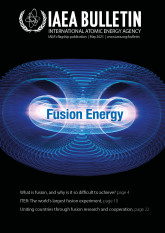
If you would like to learn more about the IAEA’s work, sign up for our weekly updates containing our most important news, multimedia and more.
Burning plasma
A critical stepping stone towards fusion power
Matteo Barbarino
In our sun’s core, extreme temperatures and the immense pressure created by massive gravitational forces create ideal conditions for nuclear fusion.
Recreating that on earth, however, without the extreme gravitational forces of a star, and by means of a fusion reactor, poses many technical challenges. The biggest of these is keeping the heated fusion plasma — a charged gas composed of ions and free electrons in which the reaction takes place — at over 100 million degrees Celsius, confining its particles in a magnetic field and holding them together long enough for reactions to take place and produce energy.
Understanding and validating current hypotheses of how this hot fusion plasma behaves are among the key issues fusion scientists and engineers must address to eventually produce electricity from fusion.
“ ITER will provide us with the opportunity to study ‘burning plasmas’ in which at least 66 per cent of the total heating will come from fusion alpha particles.
A super fuel for temperatures hotter than the sun
Fuel options for fusion are limited. The fuel with the highest performance potential on earth is made from a mixture of deuterium and tritium ions — two heavier forms of hydrogen. When colliding under extreme temperatures, deuterium and tritium fuse to generate charged particles with two protons and two neutrons, known as alpha particles, as well as free neutrons. While the neutrons escape the magnetic field and do not interact with the plasma, the alpha particles are confined by the magnetic field and further heat the surrounding plasma. “Controlling this heating is critical to harnessing fusion power,” said Matthew Hole, Professor at the Australian National University.
Safe and sustainable fusion power relies on these charged alpha particles and their energy to maintain the plasma at a constant temperature, thus allowing the reactions to be self-sustaining. Achieving this is essential to operating a fusion reactor.
In the 1990s, experimental fusion reactors produced up to 16 megawatts (MW) of power for a little less than a second. In those experiments, the alpha particles provided only about ten per cent of the heat externally supplied. Understanding what happens when alpha particles provide more of the heat will be explored through initiatives like ITER — an international reactor-scale experiment under construction in France.
“ITER will provide us with the opportunity to study ‘burning plasmas’ in which at least 66 per cent of the total heating will come from fusion alpha particles. In these conditions, ITER will produce 500 MW of fusion power for up to 500 seconds,” said Alberto Loarte, Head of the Science Division at the ITER Organization. He said his organization’s experiments will provide much-needed answers to key questions in burning plasma physics, such as how to create a plasma that is self-sustained by the internal heating from its alpha particles, and how to find optimal operating conditions for high fusion performance that are compatible with the power handling capabilities of the reactor wall.
How to make plasma self-sustaining
An important indicator of a fusion reactor’s performance is its ‘fusion power gain’, which is determined by the plasma’s temperature, density, and energy confinement time — a measure of how effectively the magnetic field maintains the plasma energy over time. Creating a self-sustaining reaction requires a temperature of about 100 million degrees Celsius, a density that is one million times less that of air and the energy confinement time of just a few seconds.
Although the conditions required are well understood, how they can be reached simultaneously is far from obvious. For example, increasing the plasma density is advantageous in principle, as it increases the likelihood of fusion reactions. However, as the density approaches its maximum, many experiments show that plasma confinement degrades more than expected, says Richard Hawryluk, Associate Director for Fusion at the Princeton Plasma Physics Laboratory in the United States of America.
For the ITER experiment to succeed, solutions to these problems need to be found, and much of the research to do so requires international cooperation. Through its series of Technical Meetings on energetic particle physics, plasma control, and fusion data acquisition, validation and analysis, the IAEA provides a platform for the exchange of scientific and technical results, and is helping to develop modelling tools that can be used to predict the behaviour of fusion plasma in ITER and future fusion power reactors.
Finding the ‘sweet spot’
One of the greatest challenges is finding optimal operating conditions with maximum fusion power and plasma control that would allow for high performance without breaching operational boundaries for long periods. Breaching operational boundaries is problematic as it could lead to instabilities that can terminate the plasma in a phenomenon known as plasma disruption.
“In a torus-shaped tokamak type reactor, like ITER, a disruption could rapidly terminate the plasma over a few milliseconds and generate substantial thermal and mechanical stress to the reactor’s components,” said Michael Lehnen, Scientific Coordinator for ITER Organization’s Stability & Control Section. “The IAEA is helping to avoid this scenario by fostering information exchange on experimental, theoretical and modelling work in this area, with special emphasis in the next few years on developing a solid basis for the design of ITER’s disruption mitigation system.”
Recent experiments and modelling efforts incorporating artificial intelligence-based methods are shedding light on the requirements for effective plasma control — helping to pave the way for the safe design and operation of future fusion power plants. “Powerful advanced statistics and machine learning approaches applied to disruption research can help identify significant patterns and reveal hidden information in years’ worth of experimental data,” said Cristina Rea, Research Scientist at the Massachusetts Institute of Technology (MIT) Plasma Science and Fusion Center.
A productive synergy among control physicists, modellers, scenario developers and data engineers is emerging, where new solutions are being designed to avoid these disruptive boundaries. More work must be done to evaluate the applicability of these data-driven methodologies for projects such as ITER, but the results thus far are encouraging, Rea said.


